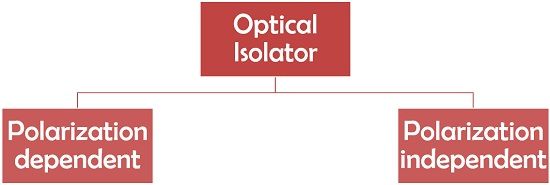Definition: An optical component that permits the propagation of the light signal in one direction only and completely blocking the other direction is known as Optical Isolator. Faraday effect is the basis of working of this device.
Basically, when a light ray is allowed to pass through the fiber then there are some chances that it may get reflected back. So, to avoid backward reflection of transmitted signal optical isolators are used.
It is also known as optoisolator, photocoupler etc. These are majorly used in laser applications. Due to this, the coherence of light does not get affected.
Components of Optical Isolator
The device consists of mainly 3 components namely, input and output polarizer it can be 2 input and output birefringent plate that acts as a polarizer and a Faraday rotator.
The whole operation of the isolator relies on these three components. Now, let us move further and understand the major types of the optoisolator.
Types of Optical Isolator
An optical isolator is majorly classified into the following categories:
These are mainly categorized on the basis of their polarization characteristics.
Polarization dependent isolator: A polarization dependent isolator is composed of mainly input and output polarizer along with Faraday rotator. These are mainly used in free space optical system as the system maintains the polarization of the source.
Polarization independent isolator: A polarization independent isolator is composed of input and output birefringent wedges along with Faraday rotator. It basically consists of 2 collimators. As firstly, at the time of transmission the beam gets splits and then merged afterwards thereby focusing at the other collimator.
But in the reverse direction, the ray gets split after which it gets diverge and hence not get focused at the collimator on the other side.
Working principle of Optical Isolator
As we have already discussed that it is basically used to direct the transmitted radiation in a single direction by avoiding the chances of backward reflection.
So, let us understand how this happens:
The figure below shows the design of the isolator consisting of 3 components:
Let us now understand how it operates:
As we can see in the figure shown above that the first component is input polarizer. So, light ray on passing through this polarizer gets vertically polarized. This vertically polarized light then fed to a Faraday rotator.
Faraday rotator is nothing but an optical device that rotates the polarization of light because of Faraday effect. It is to be noteworthy here that this effect is non-reciprocal and it is based on magneto-optic effect.
In the case of the optical isolator, the rotation angle of Faraday rotator is 45°. As we have already mentioned in the previous paragraph that it is non-reciprocal that means it simply rotates in a single direction.
After the light ray undergoes a rotation of 45°, then it is allowed to leave through the polarizer placed after the rotator i.e., the output polarizer. The polarizer at the output either absorbs or reflects the light but that relies on the type of polarizer.
Now, let us understand how the light ray does not get reflected by using the same arrangement.
The light absorbed at the output polarizer is allowed to fall at the Faraday rotator. The figure below represents the arrangement when the light is again reflected towards the rotator.
The rotator now rotates the light ray again by 45° in a non-reciprocal manner i.e., in a clockwise direction. After this rotation, the light ray gets horizontally polarized as we can see in the figure shown above.
But, the input polarizer is basically a vertical polarizer. So, the horizontally polarized light will get rejected by the vertical polarizer.
Hence, in this way, no any light ray will get scattered or reflected back at the input by using these 3 components.
This is an optical isolator works.
Applications of Optical Isolator
- In the optical communication system: These finds wide applications in optical fiber communication system. As at the time of signal transmission, these devices reduce the chances of signal losses due to reflection.
- In the optical amplification unit: An amplifier boosts the signal level so if we use an isolator along with an amplifier then it will result in better amplification of the transmitted signal.
- In laser diodes: The laser light source is used to provide a highly coherent light wave. So, when it will be used with an isolator then the chances of having highly coherent radiation will become more.
So, from the above discussion, we can conclude that an optical isolator is one of the major devices used at the time of optical communication.

